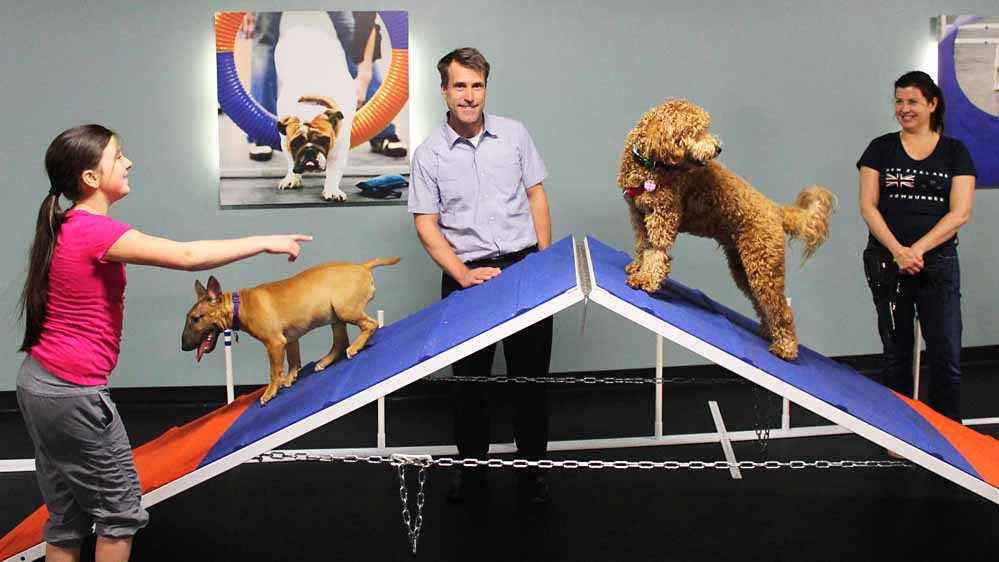Efficient Approaches for Effective Pet Dog Training: A Comprehensive Overview
Reliable pet training calls for a nuanced understanding of canine actions. It depends upon the concepts of favorable support and uniformity. Instructors must recognize the significance of necessary commands and socializing. Addressing common behavioral issues can transform a dog's disposition. As the bond between owner and pet dog enhances, the way they interact develops. The journey of successful training encompasses different techniques that may shock even skilled pet owners. What are the crucial components that can make a significant difference?
Recognizing Canine Behavior
Comprehending canine habits is vital for efficient canine training, as it enables trainers to interpret a pet's actions and reactions in numerous scenarios. Dogs communicate mostly via body language, articulations, and face expressions. Recognizing indications of hostility, anxiety, or fear can help instructors change their techniques to guarantee a favorable training experience. A wagging tail does not constantly show happiness; the context and other body signs must be thought about.
In addition, comprehending a pet's breed-specific qualities can offer understandings right into their behavior patterns and impulses. Socializing plays a vital duty fit a pet dog's feedbacks to new people and atmospheres. Observing a pet dog's play design can additionally reveal their temperament and convenience degrees. By very carefully examining these habits, instructors can develop tailored strategies that foster discovering and reinforce the bond in between canine and owner, eventually leading to more effective training outcomes.
The Value of Positive Support
Favorable reinforcement is an essential technique in canine training that boosts the discovering process by fulfilling preferred behaviors. This approach urges pets to duplicate activities that produce positive outcomes, such as treats, appreciation, or play (Dog Training Near Me). By linking etiquette with benefits, canines end up being much more motivated and engaged throughout training sessions

Integrating positive support right into training regimens can lead to quicker understanding and far better retention of commands. It advertises a happy environment that improves both the pet's experience and the instructor's satisfaction, making it a basic aspect of effective pet training.
Crucial Commands Every Canine Need To Know

Creating a Consistent Training Set Up
Establishing a constant training routine is important for efficient pet training, as it assists reinforce understanding and produces a feeling of routine for the dog. A structured approach allows both the trainer and the pet dog to prepare for training sessions, which can boost emphasis and interaction. Ideally, training sessions need to be short, enduring in between 5 to 15 minutes, to maintain the canine's attention and interest.
Including training right into daily activities, such as nourishment or walks, can also advertise consistency. This integration assists canines link training with favorable experiences. It is very important for fitness instructors to remain versatile; unforeseen occasions might demand changes to the schedule.
In addition, repetition is key. Routine practice of commands and habits strengthens discovering and develops confidence. By adhering to a regular schedule, trainers can ensure that their pets develop great habits and react dependably to commands, laying the groundwork for efficient training outcomes.
Socialization: Key to a Well-Adjusted Canine
Socializing is vital for a pet's advancement, influencing their habits and communications with people and various other pets. Early direct exposure to numerous environments, sounds, and experiences can greatly improve a pet's flexibility and confidence. Using reliable socialization methods can assist assure a well-adjusted canine friend.
Significance of Very Early Socializing

Techniques for Efficient Socializing
While many pet owners acknowledge the relevance of socializing, understanding efficient methods to promote this process is crucial for fostering a well-adjusted pet dog. Progressive direct exposure to diverse environments, individuals, and other animals can substantially improve a pet's convenience level in numerous scenarios. Positive support plays a crucial duty; rewarding desired habits urges canines to come close to brand-new experiences with self-confidence. Structured playdates with well-mannered dogs assist develop social abilities and alleviate worry responses. Registering in obedience courses can also provide regulated atmospheres for socialization. Maintaining a calm behavior as an owner strengthens the canine's feeling of safety and security, allowing for even more successful communications. These techniques jointly add to a adaptable and navigate to this site well balanced canine buddy.
Taking Care Of Usual Behavioral Issues
Managing usual behavior problems is vital for keeping a harmonious relationship between dogs and their owners. Secret obstacles such as aggression, extreme barking, and leaping actions call for targeted techniques to take care of effectively. Comprehending the root creates of these behaviors can result in successful interventions and a much more well balanced canine friend.
Resolving Aggression Issues
Aggression in pet dogs can materialize in different kinds, posing challenges for owners and trainers alike. Resolving these concerns demands a thorough understanding of the underlying causes, which may consist of source, worry, or territoriality safeguarding. Determining triggers is necessary; proprietors need to observe their pet's body movement and habits to identify try these out particular situations that prompt aggressiveness. Favorable support techniques can effectively modify aggressive actions, satisfying calm responses to identified triggers. Uniformity is essential, and owners must remain individual throughout the training process. In some cases, specialist support from a certified pet instructor or behaviorist may be required, particularly for severe aggressiveness. Inevitably, the goal is to develop a safe setting for both the pet dog and those around it.
Managing Extreme Barking
Too much barking can be a substantial annoyance for pet owners and next-door neighbors alike, commonly signaling underlying problems that require resolving. Determining the triggers behind the barking is essential; these might consist of dullness, stress and anxiety, or a feedback to external stimulations. Proprietors must observe their pet's behavior and atmosphere to pinpoint the cause. Dog Training Near Me. Applying consistent training methods, such as favorable reinforcement, can successfully lower barking. Instructing commands like "silent" or rerouting the dog's interest currently of barking can be useful. In addition, giving adequate physical and mental excitement through exercises and interactive toys can ease boredom-related barking. In some cases, seeking advice from a specialist instructor or behaviorist may be required to establish customized methods that attend to relentless barking problems
Reducing Jumping Behavior
Numerous canines display leaping actions, often as a means of expressing excitement or seeking interest from their site visitors and proprietors. This actions can be bothersome, specifically when it brings about unintentional injuries or pain for visitors. To decrease jumping, owners should initially remain calm and avoid rewarding the actions with focus, as this can reinforce it. Rather, they can show an alternate habits, such as resting, by awarding the dog for continuing to be tranquility when someone strategies. Uniformity is essential; all member of the family must apply the exact same policies. In addition, training sessions ought to include disturbances to aid the pet discover to control their impulses. Over time, with perseverance and persistence, jumping can be considerably lowered, leading to a more positive setting.
Developing a Strong Bond With Training
Training a pet dog frequently concentrates on commands and behaviors, it also serves as an essential chance to reinforce the bond between the pet dog and its proprietor. Participating in training sessions promotes interaction, good understanding, and trust fund. When owners spend time in educating their canines, they show dedication, which helps the canine really feel safe and secure and valued. Positive reinforcement methods, such as deals with and praise, not only motivate preferred actions but also strengthen the psychological link in between the dog and owner.
Consistency in training develops a sense of integrity, permitting canines to understand their duty within the home. Each effective command boosts the dog's confidence, causing a much deeper partnership. Normal training sessions can come to be enjoyable bonding experiences, loaded with playfulness and communication - Dog Training Near Me. Ultimately, the process of training transcends mere obedience, creating a collaboration that improves the lives of both the pet and its proprietor
Regularly Asked Inquiries
What Age Is Finest to Begin Training a Young Puppy?
The very best age to start educating a pup is typically between 8 to 12 weeks. At this phase, pups are most responsive to discovering, making it a suitable time for foundational training and socialization.
How Lengthy Should Each Educating Session Last?
The suitable duration for each dog training session typically varies from 5 to 15 mins, depending upon the pet's age and interest span. Short, concentrated sessions boost discovering and retention, making training more effective and delightful.
Can Older Canines Still Be Trained Properly?
Older pet dogs can certainly be educated effectively. With persistence and regular methods, they can find out new commands and actions. Their experience commonly makes them much more responsive to training, improving the bond in between canine and proprietor.
What Devices Do I Required for Training?
For reliable pet training, important tools includes a tough leash, a comfy harness, high-value deals with, training clickers, and a variety of playthings. These tools facilitate communication and strengthen favorable behaviors throughout training sessions.
How Do I Track My Pet's Training Progress?
To track a pet dog's training development, one can keep a journal, record landmarks, and note behavioral modifications. Normal evaluations, consisting of timed commands and obedience examinations, help determine enhancement and identify locations needing additional attention.
Comprehending canine behavior is vital for efficient pet training, as it enables fitness instructors to translate a pet dog's activities and reactions in numerous scenarios. Establishing a regular training routine is vital for efficient dog training, as it why not check here helps strengthen knowing and creates a sense of routine for the canine. Training a pet dog frequently concentrates on commands and actions, it additionally serves as an essential opportunity to reinforce the bond between the pet and its proprietor. When owners invest time in instructing their dogs, they demonstrate dedication, which helps the pet really feel safe and valued. The perfect period for each dog training session typically varies from 5 to 15 minutes, depending on the pet dog's age and interest span.